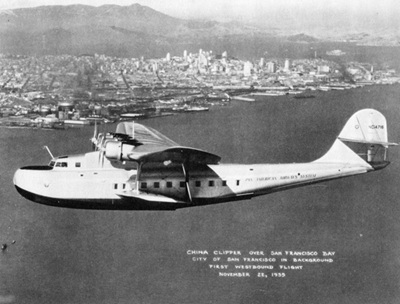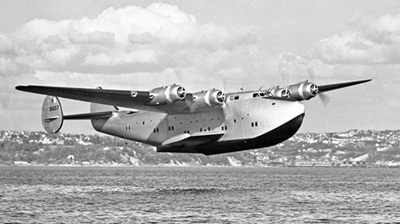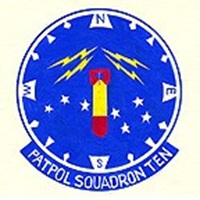President Roosevelt sent the following to Commander McGinnis follwoing the flight: "Heartiest congratulations to you and all associate with you in preparing for and successfully completing the greatest undertaking of its kind in the history of aviation - the formation flight from San Fransisco to Honolulu, Hawaii. It was a magnificent accomplishment." Henry L. Roosevelt, Assistant Secretary of the Navy wrote, "Well done. The Navy is proud of your squadron. My congratualations and warm regards to officers and men." Chief of Naval Operations Rear Admiral William H. Standley sent a short and to the point message, "Congratulations, well done!." Rear Admiral Earnest King stated in his message, "The chief and and officers of the bureau of Aeronautics heartily congratulate the commander of Squadron 10, his officers and men on their succesful and workmanlike accomplishment in this nonstop flight from San Fransisco to Honolulu, which is the longest formation nonstop flight in the history of aviation."
The flight had broken three records. The first was for the longest massed flight in history, breaking the previous record set by Genaral Balboa in 1933 by 536 miles. It was also a record for the longest flight by a seaplane. An example how fast aviation was progressing is the fact that this record would be broken by October 1934. The main acheivement of this flight was that it was made with aircraft that had not been specifically modified for the flight, and in fact set the stage for routine transfer of aircraft to Hawaii.
Admiral King went on to state the importance of the new aircraft in observation over the vast areas of the Pacific and their ability to carry bombs when necessary. Naval officials reinforced that opinion pointing out that aircraft in the flight were used for "patroling for enemy submarines, protection of convoys, and long-distance scouting from advanced bases." This last section of the message was not a side note. On January 13, the Japanese issued a statement they were considering giving the two-year notice to withdraw from the Washington Naval Treaty. They did so on December 29, 1934.
VP-10F would soon be used for long-distance scouting. The P2Y-1 offered endurance and distance the earlier models could not match, and squadron took advasntage of it. The squadron investigated island and atolls that had been previously out of reach, sometimes anchoring and sleeping on the beach or meeting a prepositoned seaplane tender. The only areas they were not allowed to go to were the mandated islands, which were previous German-held locations turned over to Japan at the end of World War I. As Admiral Herbert Riley recalled, "All of our fleet operations were in preparation for a potential war with Japan."

Riley noted also that while the P2Y was a sturdy, excellent seaplane, it was also underpowered. This would change with the introduction of NEW ENGINES and aircraft design. In many ways, these developments were lead by the commercial interest inspired by the filght of VP-10F to Hawaii. As early as 1932, Pan Am had announced plans for non-stop air service to Hawaii. In 1934, Pan Am negociated landing rights for Pearl Harbor, Midway Island, Wake Island, Guam, and Manila, and had sent construction teams out by March 1935 to setup way stations for the 5 day trip. In April 1935, Pan Am flew a Sikorsky S-42 flying boat to Honolulu as a survey flight. On November 22, 1935 the first regularly scheduled flight took off from San Fransisco to China using a Martin 130 flying boat (Right).
Following his historic flight, Commander McGinnis had opined that regular air mail service was not far off. He was not wrong. The Pan Am had exclusive rights to carry the foreign mail for the U.S. governemnt.
The first flight to Hawaii was also the first regular trans-Pacific airmail service.  Postmaster General Farley came from Washington, to watch the historic flight stated that it was “the beginning of the most significant achievement in the development of air transportation.”
Though the Martin 130 was able to make the flights, in 1936 Pan Am put out a request for bids for a larger, more luxurious aircraft. The Boeing 314 won the competition and
was entered into service in 1939, the same year Consolidated PBYs began replacing the P2Y-3 (Left) Developments.
Postmaster General Farley came from Washington, to watch the historic flight stated that it was “the beginning of the most significant achievement in the development of air transportation.”
Though the Martin 130 was able to make the flights, in 1936 Pan Am put out a request for bids for a larger, more luxurious aircraft. The Boeing 314 won the competition and
was entered into service in 1939, the same year Consolidated PBYs began replacing the P2Y-3 (Left) Developments.
The rapid developments in aircraft and engine design, and the advent of World War II, quickly shoved the flight of VP-10F into the shadows of history. While the acheivments of the squadron were overshadowed rapidly, the Flight of the Rangers heralded the rapid advances in long distance navigation, radio communications and design that would eventually make air travel the predominant means of transportation after World War II.


